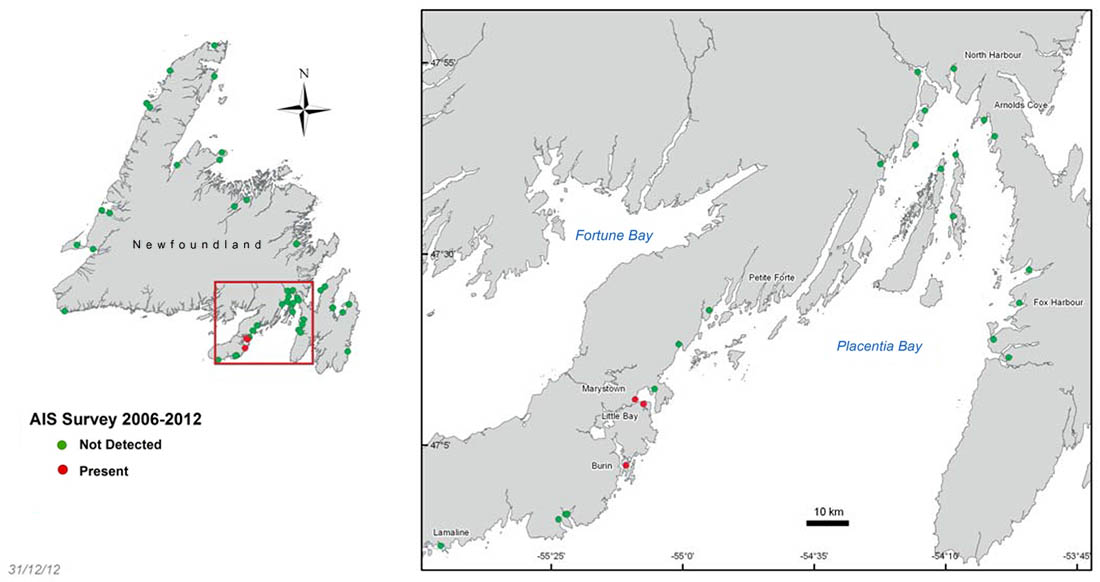Vase Tunicate in Newfoundland and Labrador Waters
Tunicates are aquatic animals with a sac-like body protected by an outer body covering called a 'tunic'. They occur in two forms, either individually (solitary) or integrated into groups (colonial). Each individual animal feeds by filtering seawater through their bodies.
The vase tunicate (Ciona intestinalis) is a solitary tunicate believed to have originated in the Northeast Atlantic. Its earliest record in North America was in the eastem United States in 1850 and on the Canadian east coast (New Brunswick) in 1852. It was first discovered in Newfoundland waters on September 19, 2012 (see map). Vase tunicates have an elongate, translucent body (often pale yellow, green or orange in colour), and can grow up to 15 cm in length. They attach to virtually any hard, natural or man-made substrate, often in large groups, making them a major bio fouling organism. They may reproduce continuously in waters above 8°C, releasing eggs and sperm which fertilize and form free-swimming larvae. Larvae must settle within 1-6 days to survive - which limits their natural dispersal to a short distance.
Temperature and salinity play a major role in the growth and reproduction of vase tunicate. In temperate or shallow regions, Vase tunicates may live 12-18 months and produce two generations per year; however they may live 2-3 years and reproduce once a year or less in deeper, colder areas.
Environmental Impact of Vase Tunicate
Since the vase tunicate is a filter feeding animal, it is a natural competitor for other filter feeders (including mussels and other commercial bivalves). Aquaculture farms in the Maritimes (particularly Nova Scotia and Prince Edward Island) have reported decreased size and condition of commercially raised mussels, increased harvesting costs due to tunicate removal, and water quality issues on fish farms. The vase tunicate is mostly composed of water, and in dense aggregations can carry substantial weight. This added weight may lead to increased maintenance cost to boaters, as well as decreased boat speed and maneuverability.
Discovery and Survey Findings
Vase tunicate was first identified on September 19, 2012, during a DFO wharf and breakwater dive survey in Burin, Placentia Bay. This is the first record of vase tunicate in Newfoundland waters. Follow-up surveys in October and November 2012 discovered vase tunicate was also present in Little Bay and Marystown. The greatest abundance was found in Little Bay on wharf pilings, boat hulls, ropes, buoys, kelp, and eelgrass blades. Smaller numbers were found in Burin and Marystown on wharf structures. The species has not been found on any Newfoundland aquaculture farm to date.
Methods to Control the Spread of Vase Tunicate
Vase tunicate is listed as the most problematic invasive species to mussel aquaculture in the Maritime provinces, and therefore every effort must be made to prevent the spread of the species to Newfoundland mussel aquaculture farms.
Tunicates can be easily spread through movement of gear, shellfish, and commercial and recreational boats. To control the spread of vase tunicate, boat hulls and gear should be visually inspected and cleaned regularly by letting air dry for at least 48 hours. Care should be taken that plant and animal material and water is disposed of on land and no materials go back into the water. Antifouling paints are effective in preventing settlement of vase tunicate and should be applied regularly. Every effort should be made to remove populations from wharves and surrounding structures.
Surveys and monitoring for vase tunicate in Newfoundland are effective tools in early detection. Early detection of recently established populations may provide an opportunity to control, contain, or ideally eradicate new populations before they spread. Research is ongoing to learn about the biology of this species in the Newfoundland environment and to develop mitigation methods and communication strategies to control and prevent its spread throughout the province.
References
- Carver, CE, Mallet AL and Vercaemer B (2006) Biological Synopsis of the Solitary Tunicate Ciona intestinalis. Can. Man. Rep. Fish. Aquat. Sei. 2746: v + 55 p.
- Pollock LW (1998) A practical guide to the marine animais of Northeastem North America. Rutgers University Press, New Brunswick, New Jersey. 367 pp.
- Sargent P, Wells T, Matheson K, McKenzie CM & Deibel D (2013) First record of vase tunicate, Ciona intestinalis (Linnaeus, 1767) in coastal Newfoundland waters. Biolnvasions Records (2013) Volume 2, Issue 2: 89-98
© Her Majesty the Queen in Right of Canada, 2013
DFO/2013-1896
Cat. No.: Fs23-555/5-2013E
ISBN: 978-1-100-22528-9
- Date modified:


